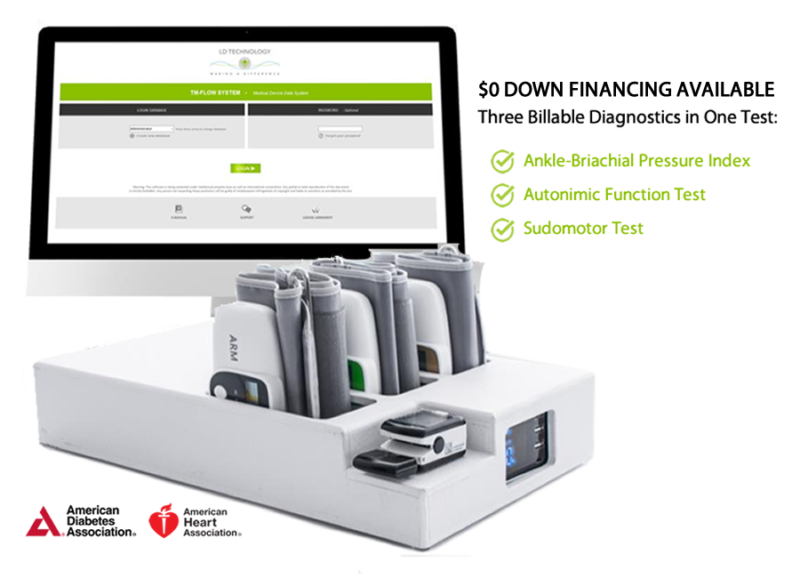Frequently Asked Questions
The TM Flow device offers numerous benefits for medical practices, including non-invasive and accurate testing, early detection of autonomic and arterial dysfunctions, and comprehensive diagnostics that reduce the overall cost of patient care. Additionally, the device’s tests are easy to bill with multi-code diagnostics, making it a valuable investment for enhancing patient care and optimizing practice efficiency. It also supports compliance with standards of care recommended by leading health organizations.
Yes, the TM Flow device is covered by Medicare and most private pay carriers. Specific CPT codes, such as 95921 for cardiovagal innervation and 93923 for ankle-brachial pressure index, ensure that the diagnostics are easy to bill. Coverage and reimbursements may vary depending on the Medicare locality, but the comprehensive diagnostics offered by the TM Flow device are widely recognized and supported by insurance providers.
Autonomic nervous system testing is crucial for diabetes and cardiovascular patients because it helps in the early detection of autonomic neuropathy, which is a common complication in these conditions. Early detection through ANS testing allows for timely intervention and management, reducing the risk of further complications. The American Diabetes Association recommends ANS testing as a standard of care for patients with Type 1 and Type 2 diabetes, highlighting its importance in effective diabetes management.
The TM Flow device is an advanced, non-invasive diagnostic tool designed to perform a series of tests that aid in the identification and early detection of autonomic nervous system (ANS) and arterial dysfunctions. It provides quantitative assessments of the ANS, helping to distinguish between early and late stages of autonomic neuropathy. The TM Flow device is particularly valuable for cardiovascular and diabetic autonomic neuropathy (DAN) testing, making it an essential tool in diabetes management and cardiovascular assessments.

TM Flow in Jackson
Diabetes is a serious condition that affects millions of people throughout the world. In fact, the Centers for Disease Control and Prevention (CDC) estimates that one in four Americans has diabetes or pre-diabetes. Unfortunately, this disease is often overlooked by patients and their physicians because it can cause a wide range of symptoms and it doesn’t have a definitive test like many other diseases do. However, one symptom that does get diagnosed often enough is peripheral neuropathy—a type of nerve damage caused by diabetes that can cause pain, tingling sensations or numbness in your hands or feet. If you think you may be suffering from this condition or if you want to find out more about what causes peripheral neuropathy in general, then keep reading!
Over half of African Americans with neuropathy suffer from diabetes.
The fact that diabetes causes nerve damage is not new. However, many people do not realize how serious diabetes can be or what it can lead to. Diabetes is a disease of the pancreas that makes it hard for the body to control how much sugar goes into the blood. This condition makes it harder for your brain and nerves to work correctly, which can lead to other health problems like heart disease, stroke, kidney failure and blindness.
If you have been diagnosed with diabetes you are at risk of getting neuropathy if left untreated or poorly controlled by medications prescribed by your physician such as insulin therapy
The average cost of neuropathy care is $7500 a year.
The average cost of neuropathy care is $7500 a year. This can be broken down as follows:
- Costs associated with treatments – $2630 per patient
- Lost productivity due to pain and discomfort – $1250 per patient
- Emergency room visits and hospitalizations – $1000 per patient
Neurologists treat neuropathic pain, but the majority of patients are treated by rehabilitation specialists.
As a neurologist, I treat diabetic neuropathy. But the majority of patients are treated by rehabilitation specialists.
The same goes for peripheral neuropathy, which is another type of nerve damage that can occur in diabetes. The majority of patients are treated by rehabilitation specialists, not neurologists.
Peripheral neuropathy can develop in up to 80% of people with diabetes.
Peripheral neuropathy is a complication of diabetes that causes damage to nerves in the body. It affects more than 50% of all people with diabetes and is one of the most common forms of peripheral neuropathy. Peripheral neuropathy can develop in up to 80% of people with diabetes, although some people may not experience symptoms until years after they first develop the condition.
Diabetic neuropathy can affect a person’s vision, hearing and sense of touch throughout their entire body, which can make even simple tasks like buttoning your shirt or turning off lights difficult.
Some forms of neuropathy, like diabetic neuropathy and small fiber polyneuropathy, have a genetic basis.
Some forms of neuropathy, like diabetic neuropathy and small fiber polyneuropathy, have a genetic basis. The genes that can cause these conditions to develop are very similar in both type 1 and type 2 diabetes. In fact, some people who have one form of the disease will eventually develop the other. Genes may also determine where—in which parts of your body—you’re more likely to experience symptoms from damaged nerves. If you have family members with diabetes-related nerve damage, there’s a chance that you might inherit those same genes that make you susceptible to it too!
The FDA has rules for how medical devices are supposed to work without harming patients.
The FDA is responsible for regulating medical devices, and their job is to make sure that these devices work as intended without harming patients. The TM Flow device is different from other types of home monitoring devices in that it can be used to diagnose conditions that affect both legs at the same time. This makes it a valuable tool for healthcare professionals looking to treat patients suffering from diabetes or any other circulatory disorders.
The TM Flow is different than other types of home monitoring devices because it can be used to diagnose conditions that affect both legs at the same time.
The TM Flow is different than other types of home monitoring devices because it can be used to diagnose conditions that affect both legs at the same time. The TM Flow has been proven to have the ability to diagnose peripheral neuropathy, diabetes, and neuropathic pain. The device measures your blood pressure as you walk or stand and then analyzes how well your body is responding to its changes in posture. This test takes about 20 minutes and will give an accurate result for conditions such as diabetes, peripheral neuropathy, and even Parkinson’s disease!
Conclusion
The TM Flow device is the first monitor that has been approved by the FDA and can be used to diagnose a variety of conditions that affect both legs at once. This is a huge step forward in diabetes care and it may lead to future innovations in how we treat other diseases as well.
RSS FEED
- The TM Flow is a highly reimbursable diagnostic in Portland, OR
- Pain Clinics in Albuquerque, NM Adopt the TM Flow as Gold Standard
- Neuropathy in Philadelphia, PA can be detected with the TM Flow device
- Pain Management Clinics in Dallas, TX are Using the TM Flow to Diagnose Symptoms
- Unlocking the Potential of ANS Testing: Insights for Healthcare Providers
- Neuropathy clinics in Savanah, GA use the TM Flow
- Come to Charleston, WV to Get a TM Flow
- How the TM Flow will maximize your physician practice in Boise Idaho
- Doctors in Pittsburg, PA are using the TM Flow for the treatment of neuropathy
- Which Patients Require ANS Testing?
